How to Get Rid Of Armadillos
44 min read Updated for October, 2019
The word Armadillo means “little-armored one” in Spanish, in reference to the bony plates that cover these prehistoric-looking mammals. You might think of armadillos as more of an exotic species, especially since all 20 varieties, with the exception of one, live in Latin America. But the reality is that armadillos, specifically the nine-banded armadillo, are highly adaptable creatures with a range that is spreading quickly across the US. The result is that they are becoming more prevalent, and in some cases, more problematic.
Armadillos can thrive in a wide variety of habitats, often moving into suburban areas where they can easily find shelter and food. While not dangerous, armadillos can become a nuisance when they choose to inhabit your property. They are omnivores that primarily forage for beetles, ants, grubs, and other insects, but they will also eat small vertebrates, plants, and fruit. Their foraging and digging habits are the main concern regarding the damage they can produce.
Digging burrows, which can be up to 25 feet long, and leaving holes in your yard and garden is reason enough to relocate them when they encroach on your property. Although they aren’t aggressive or dangerous, they do carry a few diseases, which is another good reason to remove them from your property.
44 min read Updated for October, 2019
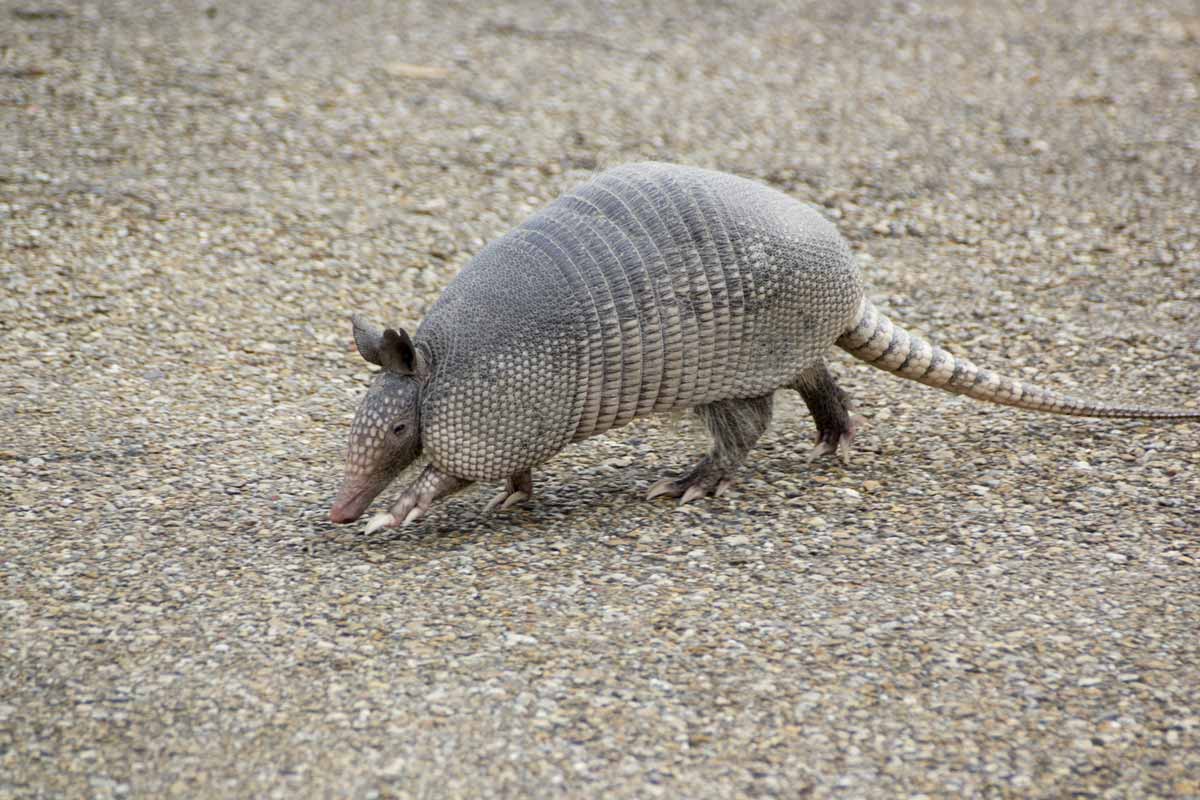
Sounds
Armadillos make grunting sounds when they forage for food and may squeak or squeal if they feel threatened. The screaming hairy armadillo is known for the loud squeals it makes, similar to, but not as loud as a pig.
Tracks
Armadillos spread their toes out when they walk, so their track are similar to those of opossums or raccoons. Their front paws have four toes with the middle two elongated, while the back have five thick toes, the middle three elongated. Each toe has a sharp claw pinpointing the tip and each print spans roughly two inches wide by three inches long. Part of an Armadillo track will include the dragging indentation of their tail.
Poop
You may be notified of Armadillo droppings by your nose first. Armadillo poop has a very strong, nasty smell, is easily stepped on and very difficult to clean up. Generally located near backyard burrowing sites, you’ll notice small groups of inch-long, brown pellets which may contain parts of the various insects they’ve digested.
Identify
Physical Characteristics of Armadillos
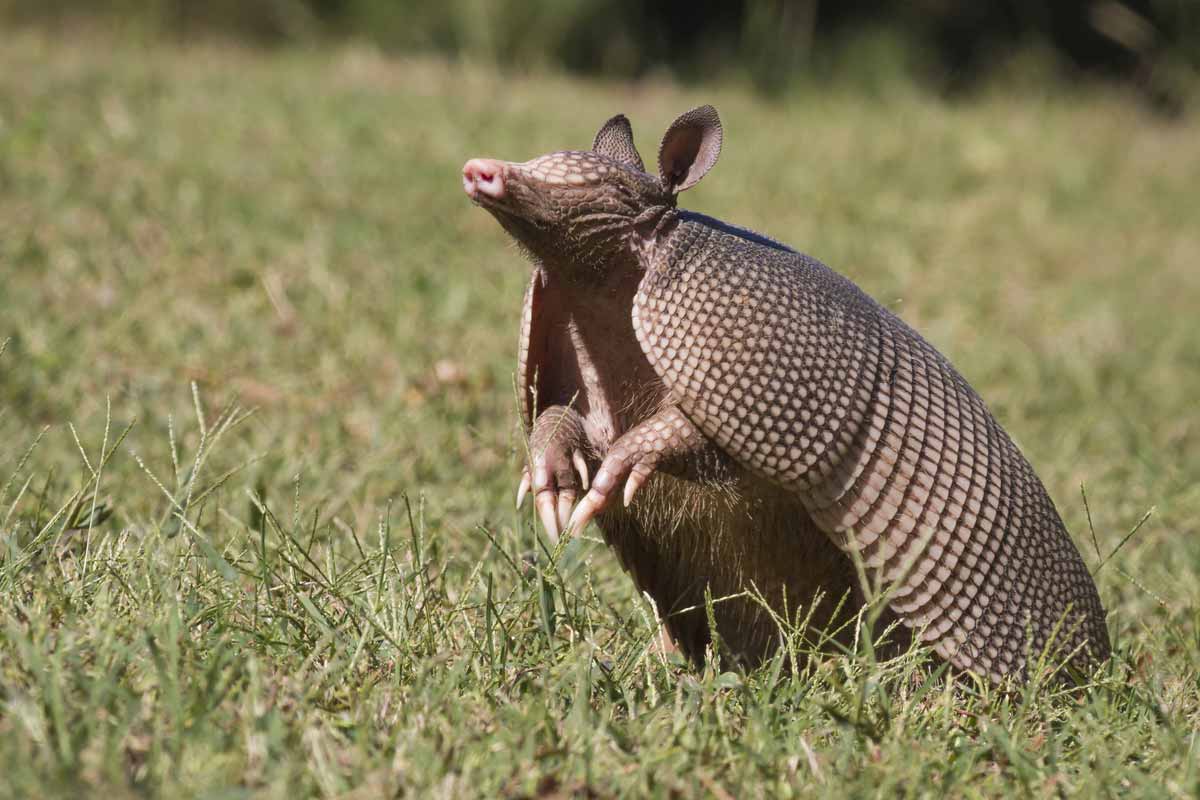
Closely related to anteaters and sloths, armadillos even have a long sticky tongue that they use to fish ants and insects out of the ground. Although they can vary greatly in appearance depending on the variety, the nine-banded armadillo is easily recognizable because of its truly unique features, which include a series of bony plates, or bands, that cover the head, back, and tail. Here is a list of the physical characteristics and features that are specific to this particular species:
Appearance
- Approximately two and a half feet long from the nose to the tip of the tail
- Weigh an average of 8-15 pounds
- Pointy, shovel-shaped snout
- Small eyes
- Strong legs and huge front claws for digging
Behavior
- Sleep 16-20 hours per day
- Forage and feed in the early morning and evening
- Mothers give birth to four identical quadruplets every year
- Armadillos can jump three to four feet vertically when startled
Treating Your Property For Armadillos
Although there aren’t many conclusive repellents that are known to keep armadillos away, there are a few treatments that may help. Armadillos do have a powerful sense of smell, so it is worth trying the following products on Amazon.com to see if you can encourage them to keep moving.
DIY Treatments
Castor Oil
This is an all-natural oil that can be used as a deterrent. It absorbs into the ground and spoils the taste of grubs and other underground insects that the animal feeds on. If you can locate the armadillo’s burrow and treat the inside with the oil, the smell will likely send them away as well.
Pine Oil
While this is not heavily substantiated and more of an old-time treatment, it may be what works for you. Armadillos dislike the strong odor of pine so using it in areas of visible damage may keep them from coming back.
Armadillos generally prefer warm, temperate climates like rain forests and grasslands.
Common Locations of Armadillos
Texas was once the northern boundary of the nine-banded armadillo’s geographic range, but they have steadily been creeping north and east for close to a century. Scientists speculate that a number of factors have contributed to their spread including lack of natural predators, general adaptability, climate change, fast rate of reproduction, and roadways that make it easier for them to move into new habitats.
Armadillos generally prefer warm, temperate climates like rain forests and grasslands. They have a low metabolic rate and very little body fat, which means that they are not able to tolerate cold climates though some have been spotted in Illinois and Nebraska. Some experts believe that armadillos may soon be spotted as far north as Washington D.C. or New Jersey.
Their ability to spread into new regions is also due to the fact that waterways don’t prove to be an obstacle for them. The nine-banded armadillos can hold their breath for six minutes and walk or swim along the bottom of a river.
Armadillos prefer habitats that have soft ground for foraging, sufficient amounts of water, and a warm climate. They typically choose to live in more rural areas without large populations of humans, but are becoming more and more commonplace in the suburbs. This is the result of humans moving into their territories as well as armadillos spreading and becoming more populous in general.
Sounds
Armadillos make grunting sounds when they forage for food and may squeak or squeal if they feel threatened. The screaming hairy armadillo is known for the loud squeals it makes, similar to, but not as loud as a pig.
Tracks
Armadillos spread their toes out when they walk, so their track are similar to those of opossums or raccoons. Their front paws have four toes with the middle two elongated, while the back have five thick toes, the middle three elongated. Each toe has a sharp claw pinpointing the tip and each print spans roughly two inches wide by three inches long. Part of an Armadillo track will include the dragging indentation of their tail.
Poop
You may be notified of Armadillo droppings by your nose first. Armadillo poop has a very strong, nasty smell, is easily stepped on and very difficult to clean up. Generally located near backyard burrowing sites, you’ll notice small groups of inch-long, brown pellets which may contain parts of the various insects they’ve digested.
Inspect
Should I Relocate this Animal?
Whether or not you choose to relocate an armadillo comes down to your personal tolerance level. Armadillos typically pose no threat to humans, though they can carry diseases and you may find their presence to be a nuisance because of the destructive nature of their digging. If they dig a burrow, or multiple burrows, you most definitely want to relocate or repel them to prevent severe damage to your home and property. Here is a list of some of the most common issues that armadillos can cause:
- Digging holes three to five inches wide in the lawn
- Uprooting plants
- Burrowing underneath structures, sidewalks, brush piles, porches, etc.
- Damaging underground pipes and wires
- Compromising foundations and creating cracks in your driveway with digging
Having said that, it is possible to trap an armadillo on your own due to their predictability and docile nature. They tend to forage the same paths so you can identify areas that they frequent, and prepare to place traps in those areas.
Before removing any animal, it is essential that you find out about trapping and relocation laws in your area. For instance, in Tennessee, it is illegal to move or transport an armadillo. Once trapped, the law requires that the animal is to be euthanized. Each state is different, so contact your local wildlife resources agency or animal control to get the information you need.
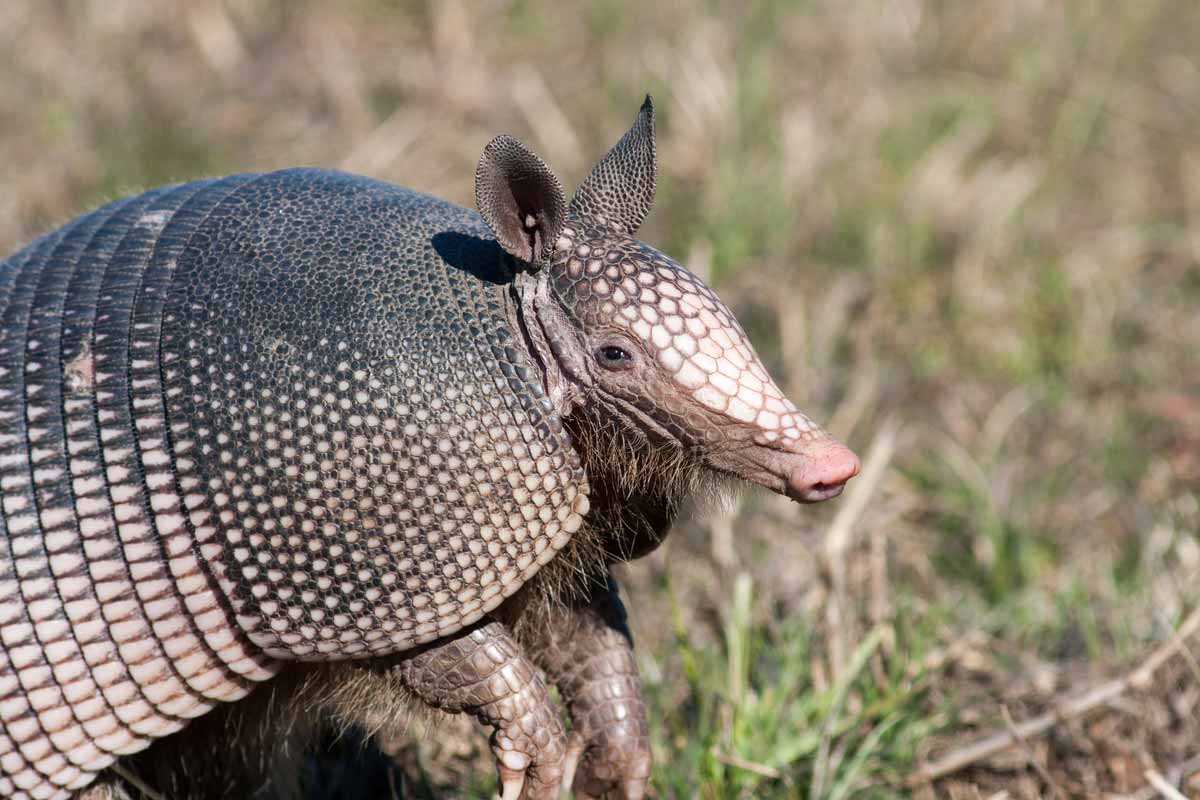
Treating Your Property For Armadillos
Although there aren’t many conclusive repellents that are known to keep armadillos away, there are a few treatments that may help. Armadillos do have a powerful sense of smell, so it is worth trying the following products on Amazon.com to see if you can encourage them to keep moving.
DIY Treatments
Castor Oil
This is an all-natural oil that can be used as a deterrent. It absorbs into the ground and spoils the taste of grubs and other underground insects that the animal feeds on. If you can locate the armadillo’s burrow and treat the inside with the oil, the smell will likely send them away as well.
Pine Oil
While this is not heavily substantiated and more of an old-time treatment, it may be what works for you. Armadillos dislike the strong odor of pine so using it in areas of visible damage may keep them from coming back.
Armadillo Problem?
Since armadillos are foragers, they are typically not interested in food that is above ground.
Gather the Tools You’ll Need
Large to X-Large Trap
It is important to get a trap that is large enough for the animal to enter fully. For an armadillo, it needs to be around 32-42 inches long and at least a foot tall.
Heavy Duty Gloves
Due to their very long claws, it is important to protect your hands and arms when handling the trap and releasing the animal.
Bait (Optional)
Since armadillos are foragers, they are typically not interested in food that is above ground. If you do choose to bait your trap, select earthworms or mealworms, both strongly favored by armadillos.
Wood Planks (Optional)
Since armadillos walk with their noses to the ground much of the time and have very poor eyesight, it may be helpful to place wood planks in a V shape that leads to the door of the trap to provide a physical guide that will direct them inside.
Set your trap right before the animal comes out to forage, usually early in the morning or the evening.
How-To Steps for DIY Removal
Select a Trap
Choose a sturdy, steel trap with either one or two doors. The primary consideration is size as you want to make sure that the entire animal can enter the trap. To make sure that the trap stays in place as the animal is entering, place it on a flat surface and put a brick or rock on top to weigh it down.
Find The Right Location
Since armadillos have poor eyesight, they tend to travel the same path that leads to and from their burrow. Try to find the animal’s burrow and from there determine the common paths they are walking. Since you cannot rely on bait to lure the armadillo, it is important to place the trap directly in its path. Here are a few suggestions:
- Right above the entrance to the burrow
- Along a fence, wall, or natural boundary a short distance from the burrow entrance
- On a distinct path that you can identify due to the presence of tracks or disturbed grass
Bait Trap
Armadillos instinctively look for food underground, so adding bait may not be helpful and may actually attract other kinds of animals into the trap. However, if you find that you need some reinforcements, select bait that they have a strong preference towards like worms
Set Your Yrap
Set your trap right before the animal comes out to forage, usually early in the morning or the evening. If you live in a colder climate, you may find that they are out during the day.
Monitor Your Trap
This is essential when trapping any kind of animal. You don’t want an armadillo to stay trapped longer than is necessary, so make sure to check the trap often.
You’ve Caught An Armadillo, What’s Next?
You should be well aware of the trapping and relocation laws in your state at this point, which will guide your next steps. Make sure that you are wearing heaving gloves when you handle a trap and hold it away from your body to avoid sharp claws. If the law permits you to relocate the animal, here are a few guidelines to follow:
- Make sure that you take the animal at least 5 miles from your property. They are very territorial and will often return to a burrow.
- Relocate it to a forested area with a nearby lake or stream.
- Open the trap and keep your distance, allowing the animal to exit on their own calmly.
Keep Them Away
Now that you’ve successfully trapped and relocated your intruder, there are some steps you can take to ensure that your yard is less appealing in the future. Here are a few steps to follow once you’ve removed the armadillo:
- Remove any fruit or berries that have fallen to the ground
- Armadillos prefer habitats with lots of shelter and foliage, so by opening up the spaces in your yard and removing a lot of the cover, they will be less drawn to your property.
- Make sure you fill in their old burrow with gravel to prevent them, or other pests, from moving back in.
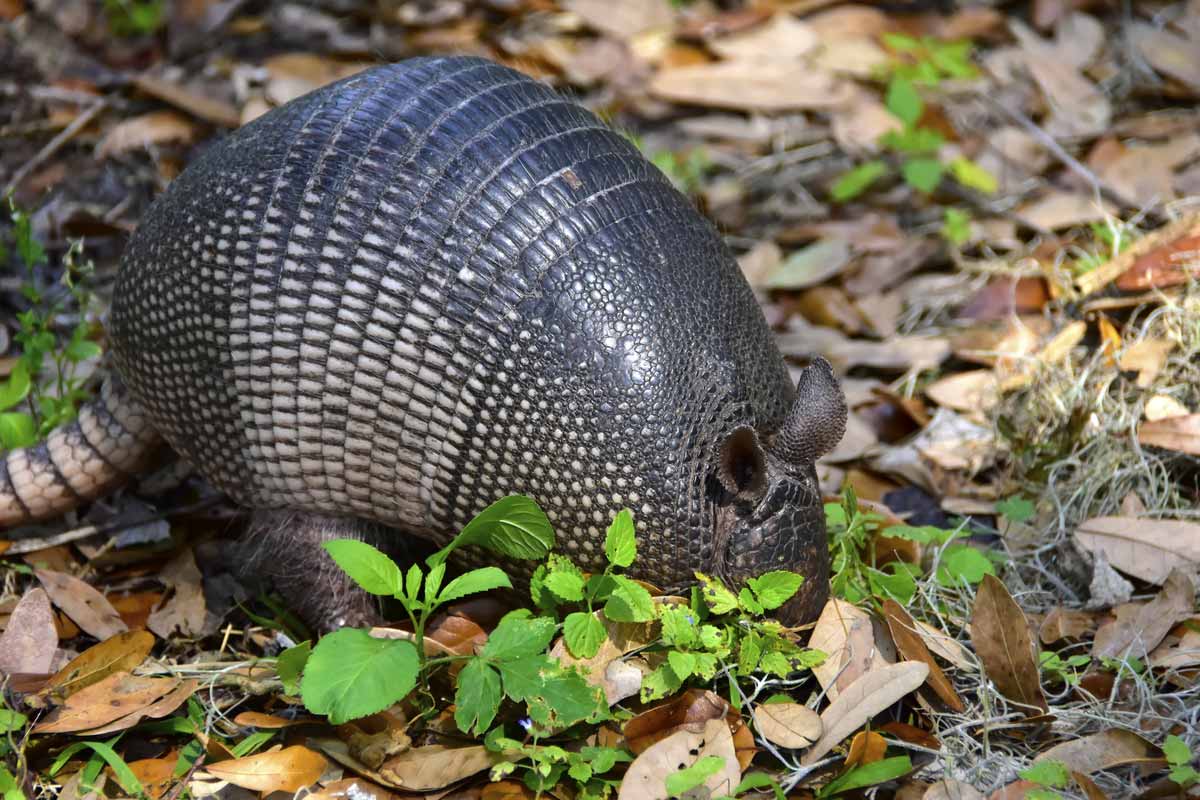
Salmonella is extremely harmful to humans and often finds its way into our food chain through food and water that is contaminated by infected animals.
Risks of Disease
Since armadillos maintain a slightly lower body temperature than most animals, they don’t carry a lot of diseases. Having said that, the diseases that they do carry are fairly serious. Here is a list of common diseases:
Leprosy
Armadillos are well-known carriers of the bacteria that causes leprosy. Their low body temperature is what makes them one of the few animals where these bacteria can thrive. The disease can be transmitted to humans through contact with armadillos, though this is rare. In the last 20 years, there have been approximately 16 million cases of human leprosy. It is estimated that there are between 30-50 million armadillos in the US and of those, about six million (20 percent) are infected with the disease.
Rabies
It isn’t common, but a small portion of the armadillo population carry rabies. Rabies is transmitted to humans and pets through a scratch or bite from the infected animal. Armadillos tend to be shy, cautious animals, especially around humans. If you do see an armadillo that is seemingly unafraid when approached or is very active during the day, then rabies could be the culprit.
Salmonella
Armadillos, along with a long list of other animals, carry salmonella. Salmonella is extremely harmful to humans and often finds its way into our food chain through food and water that is contaminated by infected animals.
Tapeworms
Tapeworms are a parasite that can be passed on to you and your pets if you come into contact with armadillo feces. They are usually contracted as eggs, which grow into worms once inside the intestine of the host.
Sounds
Armadillos make grunting sounds when they forage for food and may squeak or squeal if they feel threatened. The screaming hairy armadillo is known for the loud squeals it makes, similar to, but not as loud as a pig.
Tracks
Armadillos spread their toes out when they walk, so their track are similar to those of opossums or raccoons. Their front paws have four toes with the middle two elongated, while the back have five thick toes, the middle three elongated. Each toe has a sharp claw pinpointing the tip and each print spans roughly two inches wide by three inches long. Part of an Armadillo track will include the dragging indentation of their tail.
Poop
You may be notified of Armadillo droppings by your nose first. Armadillo poop has a very strong, nasty smell, is easily stepped on and very difficult to clean up. Generally located near backyard burrowing sites, you’ll notice small groups of inch-long, brown pellets which may contain parts of the various insects they’ve digested.
Prevent
It is tough to keep armadillos away from a particular area as there are very few effective repellents and they are unmoved by standard methods like sound devices, dogs, and sprays. Since they find their food sources underground, it is nearly impossible to eliminate that attractant. In general, they are nomadic animals and tend to continue moving rather than settle down in one place for very long. However, when they do come across an area that has the right combination of features (wet, forested land with rich food sources and lots of low lying foliage), they will likely stick around. So, here are a few ways to make your property less attractive for an armadillo:
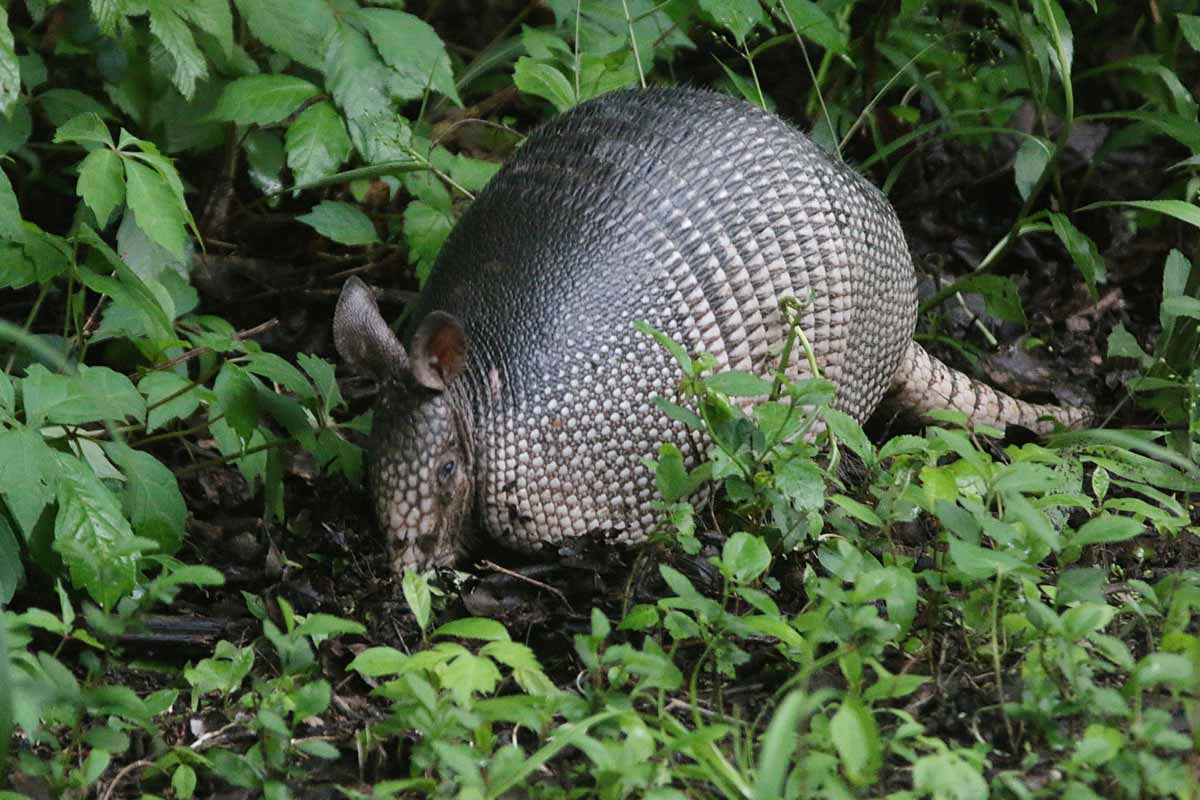
Prevention Methods
Install a Fence
The best way to prevent armadillos from coming onto your property is to install a sturdy fence that extends at least a foot into the ground. This can be costly, but if you live in an area where armadillos are a constant nuisance, it may be a wise investment. The key is making sure that the fence is buried deep enough, as they are incredibly proficient diggers and will find their way under one that merely touches the ground.
Treating Your Property For Armadillos
Although there aren’t many conclusive repellents that are known to keep armadillos away, there are a few treatments that may help. Armadillos do have a powerful sense of smell, so it is worth trying the following products on Amazon.com to see if you can encourage them to keep moving.
DIY Treatments
Castor Oil
This is an all-natural oil that can be used as a deterrent. It absorbs into the ground and spoils the taste of grubs and other underground insects that the animal feeds on. If you can locate the armadillo’s burrow and treat the inside with the oil, the smell will likely send them away as well.
Pine Oil
While this is not heavily substantiated and more of an old-time treatment, it may be what works for you. Armadillos dislike the strong odor of pine so using it in areas of visible damage may keep them from coming back.
Armadillo Problem?
Armadillos prefer habitats that are warm and wet and will be attracted to yards that have a pond or sprinkler system that keeps the ground moist.
Landscape
If fencing your yard is not a viable option, you can create an environment that is less welcoming to an armadillo by removing low-lying shrubs, dense foliage, and brush piles. They like areas that have a lot of cover, so eliminating those elements will get you one step closer to keeping them away.
Remove Excessive Water And Moisture
Armadillos prefer habitats that are warm and wet and will be attracted to yards that have a pond or sprinkler system that keeps the ground moist. By reducing areas that hold water, you are preventing grubs and worms from overpopulating, which is an attractant as well.
Sounds
Armadillos make grunting sounds when they forage for food and may squeak or squeal if they feel threatened. The screaming hairy armadillo is known for the loud squeals it makes, similar to, but not as loud as a pig.
Tracks
Armadillos spread their toes out when they walk, so their track are similar to those of opossums or raccoons. Their front paws have four toes with the middle two elongated, while the back have five thick toes, the middle three elongated. Each toe has a sharp claw pinpointing the tip and each print spans roughly two inches wide by three inches long. Part of an Armadillo track will include the dragging indentation of their tail.
Poop
You may be notified of Armadillo droppings by your nose first. Armadillo poop has a very strong, nasty smell, is easily stepped on and very difficult to clean up. Generally located near backyard burrowing sites, you’ll notice small groups of inch-long, brown pellets which may contain parts of the various insects they’ve digested.
When to Call a Professional
Armadillos are very docile creatures that sleep prolifically and cause minimal disruption outside of their digging habits. Because of this, live trapping is the best solution, and lethal action would never be necessary with an armadillo.
However, it can be tricky to trap them, and if you grow frustrated in your attempts, it is wise to call a professional for help before excessive damage occurs.
Also, if you observe an animal that you feel may be sick or rabid, avoid contact and call animal control immediately so that they can take appropriate action. Behaviors that might lead you to question the animal’s health would include a lot of daytime activity or any kind of threatening or bold behavior that goes against their natural tendencies.
Lastly, if you deem it necessary to trap or remove an armadillo during their mating season, which lasts from July-August or when babies are typically born in March, it is best to consult a wildlife expert before attempting to remove the animal.
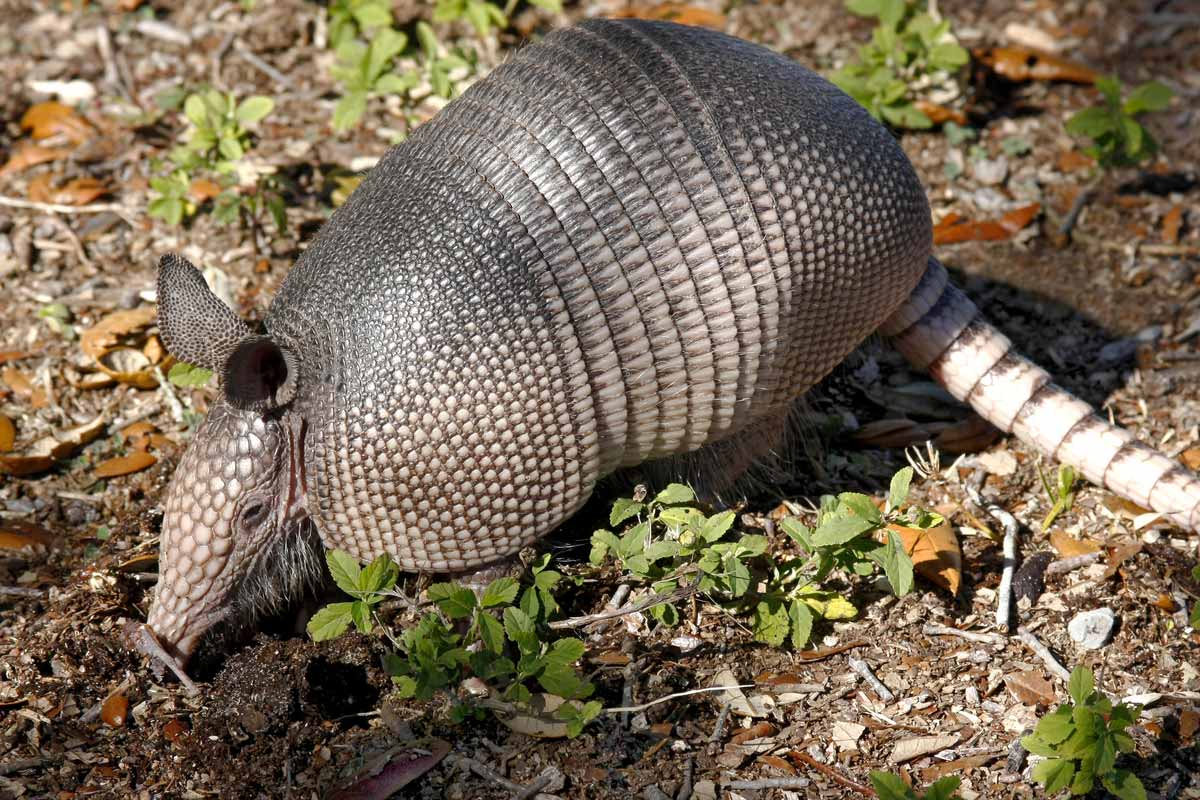
Sources
https://www.nationalgeographic.com/animals/mammals/group/armadillos/
https://www.nwf.org/Educational-Resources/Wildlife-Guide/Mammals/Nine-Banded-Armadillo
https://www.insidescience.org/news/when-invasive-species-help-armadillos-provide-shelter-native-species
https://news.nationalgeographic.com/news/2011/10/111007-armadillos-united-states-invasive-species-animals-environment/
http://www.havahart.com/how-to-get-rid-of-armadillos
https://www.sciencedaily.com/releases/2018/06/180628151918.html
http://www.wildlife-removal.com/armadillodisease.html
https://animalprosonline.com/nashville/armadillo-removal/?gclid=Cj0KCQiAgMPgBRDDARIsAOh3uyJk0LI_v4VzPjTW0bvEIAgSpUMk3xHKqEK4Ei3px6OAimGCxLSyOhkaAm49EALw_wcB
http://www.havahart.com/how-to-trap-armadillos
http://wildliferemovalusa.com/armadillo-prevention.html
Treating Your Property For Armadillos
Although there aren’t many conclusive repellents that are known to keep armadillos away, there are a few treatments that may help. Armadillos do have a powerful sense of smell, so it is worth trying the following products on Amazon.com to see if you can encourage them to keep moving.
DIY Treatments
Castor Oil
This is an all-natural oil that can be used as a deterrent. It absorbs into the ground and spoils the taste of grubs and other underground insects that the animal feeds on. If you can locate the armadillo’s burrow and treat the inside with the oil, the smell will likely send them away as well.
Pine Oil
While this is not heavily substantiated and more of an old-time treatment, it may be what works for you. Armadillos dislike the strong odor of pine so using it in areas of visible damage may keep them from coming back.
Armadillo Problem?
Sources
http://www.naturetracking.com/mammal-tracks/
https://www.trutechinc.com/services/armadillo-control/droppings/
https://armadillo-online.org/faq.html
http://www.havahart.com/armadillo-facts
Sounds
Armadillos make grunting sounds when they forage for food and may squeak or squeal if they feel threatened. The screaming hairy armadillo is known for the loud squeals it makes, similar to, but not as loud as a pig.
Tracks
Armadillos spread their toes out when they walk, so their track are similar to those of opossums or raccoons. Their front paws have four toes with the middle two elongated, while the back have five thick toes, the middle three elongated. Each toe has a sharp claw pinpointing the tip and each print spans roughly two inches wide by three inches long. Part of an Armadillo track will include the dragging indentation of their tail.
Poop
You may be notified of Armadillo droppings by your nose first. Armadillo poop has a very strong, nasty smell, is easily stepped on and very difficult to clean up. Generally located near backyard burrowing sites, you’ll notice small groups of inch-long, brown pellets which may contain parts of the various insects they’ve digested.
